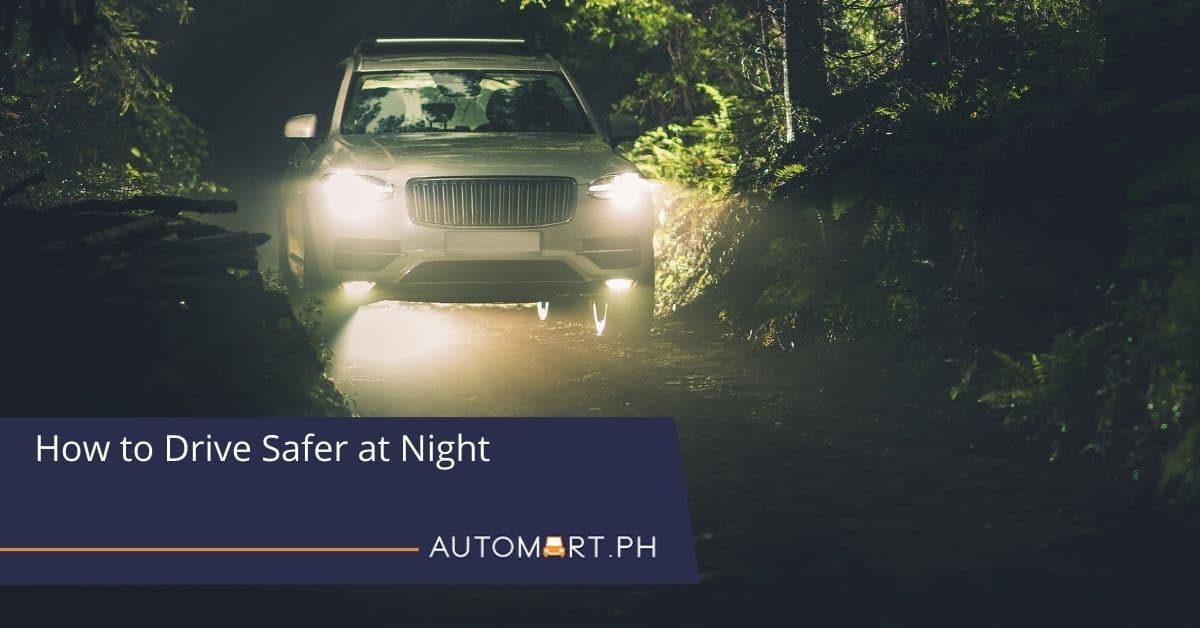
How to Drive Safer at Night
Updated on December 18 2025
What mom, dad, tito, and lola were saying is true. It is more dangerous to drive at night, and the numbers back it up. According to the US National Highway Traffic Safety Administration (NHTSA), accidents are three times more likely to occur in the dark, and it all has something to do with our eyes.

Driving at night is more dangerous since humans see less of the road ahead. Even with the high beams engaged, you only get around 500 feet of road visibility in the dark (and about 250 feet with the low beams). The inability of humans to see far ahead in the twilight mixed with higher speeds means we have less time to react when something happens on the road.
Night Time Safety Driving Tips
But it’s not all bad news. It is possible to drive safer at night, and you don’t need the eyes of an owl to do so. Here are tips to make your evening drive safer and more pleasurable.

1. Make sure the headlights are working correctly.
The headlights of your vehicle are like an extra set of eyes when driving at night. The headlight lenses should be clean and free of excess dirt and mud to maximize their effectiveness in illuminating the road ahead. Moreover, double-check that all bulbs are working and replace all busted or worn-out bulbs immediately. The same rule applies to your vehicle’s signal lights, taillights, driving lights, and fog lights.
2. Check the headlight beam angle.
The headlights will amount to nothing if the beam angle is incorrect. If the beam is tilting down, your visibility is severely compromised. But if the headlight beam is tilting up, it can blind oncoming drivers. Adjusting the headlight beam angle is not typically a DIY job, so make sure to have your car’s headlights checked at a service center or dealership at least twice a year.
3. Keep the windshield clean and clear.
Dirty windshields will not only impair your night vision. Dirty or foggy windshields will also cause glare when light from oncoming traffic hits the glass. Keep the windshield clean and clear at all times, most especially when driving at night. When cleaning the windshield, don’t forget to wipe the inside portion of the glass with a damp microfiber towel.

4. Look to the right.
Yes, it would help if you continually keep your eyes on the road while driving, but you should avoid fixing a gaze at oncoming headlights when driving at night. You can avoid being blinded by the headlights of an oncoming vehicle if you shift your gaze down and to the right, looking at the curb or lane markings as a guide to keep your car on the right track. After passing the vehicle, you can revert and lift your eyes back on the road.
5. Lower your speed.
The faster you go, the more time it takes to stop the vehicle. And with less time to react and see the road ahead, you should consider lowering your speed when driving at night. Did you know that 37-percent of night-related accidents are caused by over speeding due to poor visibility and shorter reaction times? Furthermore, avoid tailgating and consider leaving more space between your car and the vehicle in front when driving in the evening.
6. Dim your interior lights
It’s easy to get disoriented by bright interior lights from your car’s dashboard, infotainment touchscreen, and instrument display. Try dimming all those lights whenever possible when driving at night to reduce distractions.

7. Heighten your alertness.
Most night-related crashes happen between 12 midnight and six in the morning. Not all drivers are the same, and most people have trouble coping with their body’s natural circadian rhythm. When driving at night, watch out for sleepy drivers plying the roadways. If you still have a long way to go and you happen to feel tired or weary, pull over immediately and get some rest. Of course, sipping hot coffee could help.
8. Say NO to drunk driving.
Whether driving day or night, you should never get behind the wheel when tipsy or drunk. Alcohol reduces brain function, impairs critical thinking, and affects your reasoning and muscle coordination. You not only put yourself at risk when driving under the influence, but you are putting other lives at stake. Call a friend or relative to pick you up, or better yet, take a cab or hail a Grab ride instead of forcing yourself to drive when drunk, most especially at night.
Conclusion
Some people like driving late at night, and it’s not hard to understand why. There are fewer vehicles on the road during the evenings, and the cooler weather makes it acceptable to roll down the windows and have some fresh air. Keep all the above tips in mind to make your night travels safer and more enjoyable.